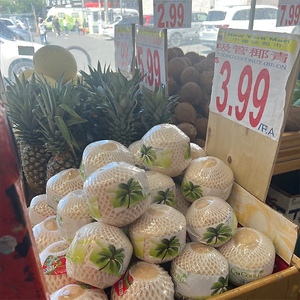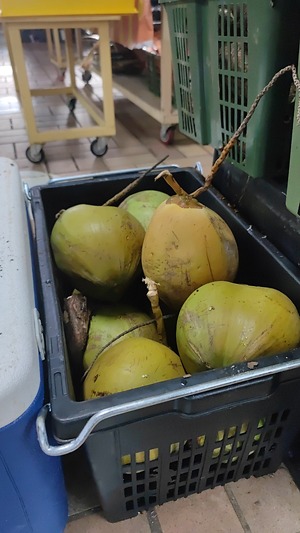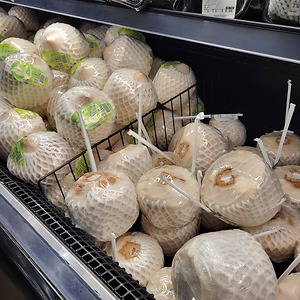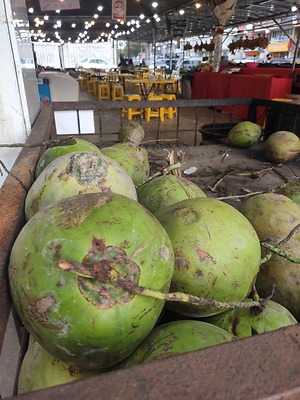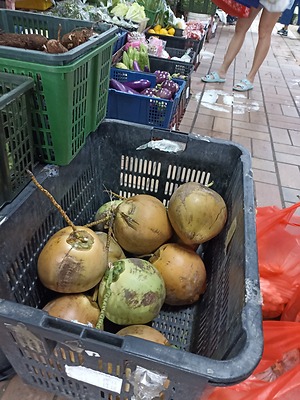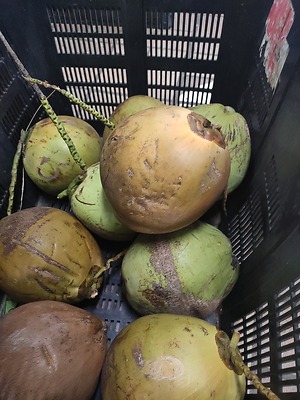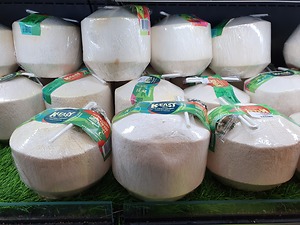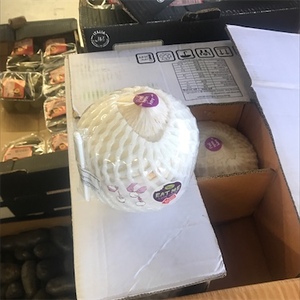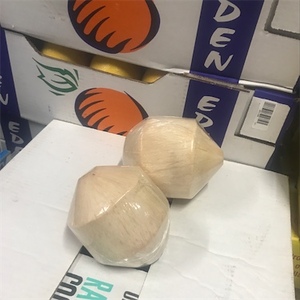


Young Coconut
Estimated Inventory, 9 ct : 16.90
This item was last sold on : 07/01/25
Description/Taste
Young coconuts vary in appearance, depending on whether they are left in their natural, rounded green state or are shaved down to a white husk. When shaved, they take on an angular appearance with rounded edges tapering to a pointed top. The shaved husk is white and has a firm, fibrous, and slightly springy consistency. Beneath the husk is a brown nutshell containing a thin layer of flesh and a central chamber filled with water. The flesh is viscous and soft, tender, and succulent. Each Young coconut will contain varying amounts of flesh and water, depending on the specific variety, maturity, and growing conditions. The flesh and water inside Young coconuts are edible raw and can be consumed straight from the source. The water is refreshing and sweet, while the flesh may bear faintly nutty, creamy, and mild flavors.
Seasons/Availability
Young coconuts are available year-round.
Current Facts
Young coconuts, botanically classified as Cocos nucifera, are the immature fruits of the coconut palm, belonging to the Arecaceae family. It is important to note that the names Young, Green, Tender, and White coconuts are typically used interchangeably worldwide. The name Young is often used in commercial settings for green coconuts shaved of excess husk. Shaving the husk removes the firm outer green layer and leaves a thin amount of interior, softer husk. This allows the coconut to be opened more easily and is a convenient method of selling green coconuts in commercial markets. Young coconuts are harvested after 6 to 8 months, and at this stage, the fruits are generally full-grown in physical size but have not reached maturity. Gathering coconuts before they are mature ensures the cavity is filled with the sweetest, largest quantities of water. The interior is also lined with a layer of jelly-like flesh. Both the water and flesh are edible and consumed as fresh snacks worldwide. Young coconuts are prevalent in Southeast Asia, and shaved versions are frequently exported from Thailand and Vietnam to commercial markets worldwide. In Southeast Asia, Young coconuts are known as Ma-Prao Orn in Thailand, Buko in the Philippines, Dua Xiem in Vietnam, and Kelapa Muda in Indonesia and Malaysia.
Nutritional Value
Young coconuts are viewed as a natural source of hydration and electrolytes. The fiber content in the flesh is believed to aid digestion, and vitamins C, E, and K help the body strengthen the immune system, guard the cells against free radical damage, and aid in faster wound healing. Young coconuts may also contain minerals like potassium, magnesium, calcium, phosphorus, and iron. Potassium balances fluid levels within the body, while magnesium controls nerve functions. Calcium and phosphorus support bone and teeth health, and iron develops the protein hemoglobin for oxygen transport through the bloodstream. Beyond vitamins and minerals, Young coconuts contain antioxidants to reduce inflammation and protect overall bodily health.
Applications
Young coconuts are filled with a layer of mild, jelly-like flesh and sweet water. These elements can be consumed directly from the coconut or extracted and incorporated into savory or sweet culinary preparations. When opening Young coconuts that have been prepped and shaved, remove as much of the white husk at the pointed top as possible until the hard nutshell inside is visible. This nutshell can be carefully cracked open with a knife to reveal the water and flesh. Once opened, the flesh can be scraped from the walls and drunk with the water using a large straw. Young coconuts are a popular beverage in Southeast Asia. Some vendors also place a few drops of vanilla into the coconut for added flavoring. Coconut flesh and water can be removed from the nutshell and blended into smoothies or frozen into sorbet and granita. Young coconut water and flesh are sometimes added to halo-halo, a popular shaved ice treat in the Philippines. The flesh is combined with other fruits and sweetened condensed milk to make a Filipino dessert called buko salad. Young coconuts are often added to puddings, jellies, and fruit dishes in Thailand and Vietnam. The flesh is also used in cakes, pies, creams, and fillings for pastries. In addition to sweet preparations, Young coconuts can be incorporated into savory dishes like curries, soups, and sticky rice. The water and flesh are also cooked into sauces to pour over grilled bananas, used to flavor steamed fish, or lightly added to egg-based dishes. Young coconuts pair well with passionfruit, longan, lychee, pomegranate, lime, pandan, lemongrass, basil, and mint. Unopened Young coconuts will keep for 1 to 2 weeks when stored in the refrigerator. Once opened, they should be consumed within 2 to 3 days.
Ethnic/Cultural Info
Young coconuts are used for their water in Buddhist funeral rituals in Thailand. Coconut water is considered one of the purest forms of water, as it never comes in contact with the ground and is stored in a clean, closed vessel. In Theravada Buddhism, it is believed that coconut water will cleanse and purify the spirit of a deceased individual to help clarify the spirit's mind for the transition into another world. Young coconuts are traditionally left in their natural state with their green husks still intact and are cut open for family members and monks to pour over the body. The ritual of cleansing with coconut water is done before the body is placed into the cremation furnace, and it begins with the senior monk pouring water from the head to the feet. The rest of the attending monks follow suit, and later, the immediate family members pour water on the body, sometimes rubbing the water on the face as a final act of love. It is believed that the coconut water will encourage the deceased's spirit to be reborn in a new world with fertile land and water. The coconut water is also thought to nourish the spirit on its travels.
Geography/History
Coconut palms are believed to have origins in India and Southeast Asia and have been growing wild since ancient times. Scientists hypothesize that there are two central areas of genetic origin: one in the Indian Ocean basin, mainly Sri Lanka, India, and the Maldives, and one in the Pacific basin, which encompasses Indonesia, Malaysia, and the Philippines. Coconuts naturally spread by floating across ocean currents, eventually sprouting and forming new trees in tropical to subtropical regions in both hemispheres. They were also spread through human intervention, as coconuts could be easily carried and transported on long voyages. Coconut palms were considered a valuable source of food, water, and construction materials. Sea trade routes eventually carried coconuts from Asia to East Africa, later introducing them to Europe. Coconuts were also spread throughout the South Pacific. Over time, European trade and merchant ships planted coconut palms in the Caribbean, leading the species to naturalize in the Americas. Today, coconut palms are found in a band around the equator, approximately 25 degrees north and 25 degrees south. The palms thrive in aerated, sandy, draining soil and are typically found in humid climates with access to fresh water. Young coconuts are harvested prematurely from the palms and are sold in their natural state in local markets worldwide. They are also trimmed of excess husk and sold as a specialty item in retail settings, especially in Europe, the United States, and Australia. In Asia, Young coconuts are popularly sold through vending machines and street vendors.
Featured Restaurants
Restaurants currently purchasing this product as an ingredient for their menu.
| Optimum Health Institute of San Diego | Lemon Grove CA | 619-589-4022 |
| Coral Del Mar | Del Mar CA | 858-449-6679 |
| Pacific Yacht Agents | Los Angeles CA | 808-214-0970 |
| San Diego Yacht Club | San Diego CA | 619-758-6334 |
| Coco Maya by Miss Bs - Bar | San Diego CA | 858-245-3780 |
| Q&A Oyster Bar & Restaurant | Oceanside CA | 858-245-3780 |
| Dot Cafe | San Diego CA | 914-263-1424 |
| Lauberge Del Mar | Del Mar CA | 858-259-1515 |
| Coco Maya by Miss Bs | San Diego CA | 858-245-3780 |
| Brigantine La Mesa | La Mesa CA | 619-465-1935 |
Recipe Ideas
Recipes that include Young Coconut. One



